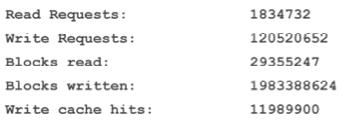VNX Solutions Design Exam for Technology Architects v8.0
Question 1
Refer to the exhibit.

A customer is analyzing the size of data sent to disk. Which command generated the output?
- A. naviseccli -h spa getdisk
- B. nas_disk -info
- C. naviseccli -h spa getlun
- D. server_stats -monitor
Answer : A
Question 2
A customer would like to implement SnapView but has expressed concern about performance. Which applications will cause performance issues?
- A. Applications with small-block continuous writes
- B. Applications with large-block random writes
- C. Applications with large-block continuous writes
- D. Applications with small-block random writes
Answer : D
Question 3
Your customer is running Exchange 2007 with VSS.
They have just purchased RecoverPoint/SE.
Which replication options are supported for their Exchange 2007 environment?
- A. Online full, online copy, online differential
- B. Online full, offline copy, online differential
- C. Offline full, online copy, online differential
- D. Offline full, offline copy, online differential
Answer : A
Question 4
While gathering performance data during peak workloads, which type of collection method is best suited?
- A. Larger periods of data collection over shorter intervals
- B. Smaller periods of data collection over shorter intervals
- C. Smaller periods of data collection over larger intervals
- D. Larger periods of data collection over larger intervals
Answer : C
Question 5
What controls the reporting of events when using Event Monitor?
- A. Unisphere Agent
- B. SP Agent
- C. Host
- D. VNX
Answer : C
Question 6
Which tool would you use for a detailed analysis of performance and troubleshooting in a
VNX?
- A. Analyzer Helper
- B. BCSD
- C. E-Lab Advisor
- D. NSD-U
Answer : A
Question 7
After deploying their new VNX, your customer has inquired about features and tools to optimize their VMware environment.
Which tools or feature enables efficient SCSI LUN reservation methods and reduces I/O traffic during cloning or zeroing operations?
- A. vStorage APIs for Array Integration (VAAI)
- B. PowerPath/VE
- C. Replication Manager
- D. Virtual Storage Integrator (VSI)
Answer : A
Question 8
The CTO (Chief Technology Officer) of mid-sized company decided to virtualize their storage environment. From the interview, you learn that the company has strict performance requirements that must be met to create a successful solution.
How should the performance requirements for the customer be determined?
- A. On a server to server basis
- B. Based on RAID and current LUN sizes
- C. By gathering back-end IOPs
- D. On an aggregate I/O basis
Answer : A
Question 9
During a customer data gathering meeting, a discussion about applications was presented.
Most of the applications will best be suited for a RAID 5 pool on the VNX. However, one of the applications has an I/O requirement for RAID 1/0 spindles.
How should the RAID 1/0 application requirement be handled?
- A. Create two separate pools, one for RAID 5 and the other for RAID 1/0.
- B. Combine the RAID 1/0 with the RAID 5 into one pool.
- C. Create a large RAID 1/0 pool.
- D. Create a large RAID 6 pool.
Answer : A
Question 10
What is the function of Usermapper?
- A. Provides UIDs and GIDs for Windows SIDs
- B. Allows UNIX users to access CIFS file systems
- C. Maps CIFS users to file systems on VNX
- D. Queries Windows Active Directory for users
Answer : B
Question 11
When documenting the customer environment prior to a storage refresh, you discover that the customer has an issue their backups do not complete every job. How should you proceed?
- A. Have the customer resolve the issue before continuing.
- B. Note the issue in the Statement of Work and continue with planning.
- C. Open a case for the backup issue and resolve it yourself.
- D. No actionrequired:SOW does not include resolving this type of issue.
Answer : A
Question 12
A VNX customer is making a decision on the type of splitters to use with RecoverPoint/SE
3.x in their environment. The environment has a small number of Microsoft Windows hosts with several LUNs greater than 2 TB. After making a decision to use host splitters, the customer realizes this is not a viable solution.
Why would the customer reach this conclusion?
- A. VNX splitters must be used when the LUN size is greater than 2 TB
- B. VNX splitters must be used if there are under 20 hosts
- C. Host splitters are only best for a large number of hosts
- D. VNX splitters must be used if there are only Windows hosts
Answer : A
Question 13
A customer has two data centers located 500 kilometers apart and uses VNX arrays in each data center for both block and file storage. Each data center is monitored and managed by Unisphere. The customer wants to deploy an integrated replication methodology to protect all of his data.
Which product will meet the customers requirements?
- A. RecoverPoint/SE (CRR)
- B. MirrorView/A
- C. Replication Manager
- D. VNX Replicator
Answer : A
Question 14
You are doing performance analysis on a VNX5100 that is configured with three virtual pools. You determine that FAST Cache would benefit overall performance. Why are you unable to configure FAST Cache on the array?
- A. Virtual pools have already been enabled.
- B. Cache memory needs to be disabled.
- C. Cache memory needs to be enabled.
- D. Engineering mode is required to enable FAST Cache.
Answer : A
Question 15
A customer wants to add a SnapView snapshot to a 300 GB LUN. Captured data shows that the LUN performs 200 random 4 KB writes per second.
What is the expected initial bandwidth at which data chunks will be written into the reserved
LUN pool?
- A. 800 KB/s
- B. 6.25 MB/s
- C. 12.5 MB/s
- D. 25 MB/s
Answer : C